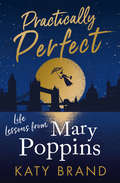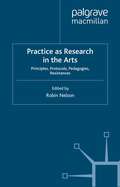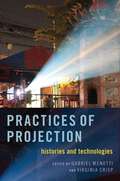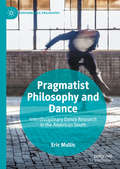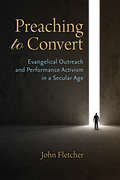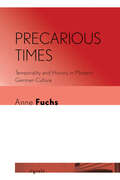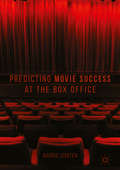- Table View
- List View
The Power of Virtual Reality Cinema for Healthcare Training: A Collaborative Guide for Medical Experts and Media Professionals
by Bob Fine Eric R. Williams John Bowditch Adonis DuradoCinematic Virtual Reality brings a combination of documentary, narrative and game design principles to the medical profession and, in the healthcare arena, collaboration is a key component for creating intellectually- and emotionally- rich immersive experiences. "The Power of Virtual Reality Cinema for Healthcare Training" gathers more than a dozen experts from both the production and healthcare fields to break down best practices for creating successful cine-VR projects. Designed for multi-disciplinary teams interested in integrating cine-VR production into their healthcare training and educational programs, this book has been written for two audiences: the healthcare professional interested in what production experts consider when approaching a project, and the media expert curious about how this new technology can be used in the medical field. Highlights include: Cutting edge medical education techniques developed by Ohio University’s GRID Lab, including: PREality (creating a forced sense of deja-vu to increase acclimation time), a unique approach to eye-tracking to enhance team performance, and the low-CRIS technique (a low-cost rapid implementation strategy to capture patient care for rapid graduate student training). Insightful production techniques that will enhance your cine-VR projects including advanced plating methods to hide lighting set-ups, immersive audio considerations, and new ways to consider 360 storytelling including the Lovrick montage and the Christmas Carol continuum for story development. Detailed explanations of the production considerations and results of specific cine-VR productions (from funding approaches to distribution) including access to more than five hours of cine-VR examples of the actual productions available for download. Details on a wide variety of medical cine-VR projects, including 100 images that illustrate best practices for topics such as recording in active medical facilities, building successful multi-disciplinary teams, working within HIPAA regulations, conceptualizing cine-VR libraries for graduate education, and implementing innovative distribution models.
The Power of Virtual Reality Cinema for Healthcare Training: A Collaborative Guide for Medical Experts and Media Professionals
by Eric R. Williams John BowditchCinematic Virtual Reality brings a combination of documentary, narrative and game design principles to the medical profession and, in the healthcare arena, collaboration is a key component for creating intellectually- and emotionally- rich immersive experiences. "The Power of Virtual Reality Cinema for Healthcare Training" gathers more than a dozen experts from both the production and healthcare fields to break down best practices for creating successful cine-VR projects. Designed for multi-disciplinary teams interested in integrating cine-VR production into their healthcare training and educational programs, this book has been written for two audiences: the healthcare professional interested in what production experts consider when approaching a project, and the media expert curious about how this new technology can be used in the medical field. Highlights include: Cutting edge medical education techniques developed by Ohio University’s GRID Lab, including: PREality (creating a forced sense of deja-vu to increase acclimation time), a unique approach to eye-tracking to enhance team performance, and the low-CRIS technique (a low-cost rapid implementation strategy to capture patient care for rapid graduate student training). Insightful production techniques that will enhance your cine-VR projects including advanced plating methods to hide lighting set-ups, immersive audio considerations, and new ways to consider 360 storytelling including the Lovrick montage and the Christmas Carol continuum for story development. Detailed explanations of the production considerations and results of specific cine-VR productions (from funding approaches to distribution) including access to more than five hours of cine-VR examples of the actual productions available for download. Details on a wide variety of medical cine-VR projects, including 100 images that illustrate best practices for topics such as recording in active medical facilities, building successful multi-disciplinary teams, working within HIPAA regulations, conceptualizing cine-VR libraries for graduate education, and implementing innovative distribution models.
The power of vulnerability: Mobilising affect in feminist, queer and anti-racist media cultures (The\manchester Spenser Mup Ser.)
by Ingrid Ryberg Katariina Kyrölä Anu KoivunenThis book investigates the new language of vulnerability that has emerged in feminist, queer and antiracist debates on media, taking a particular interest in the historical legacies and contemporary forms and effects of this language. Contributors such as Jack Halberstam and Sara Ahmed examine how vulnerability has become a battleground, how affect and vulnerability have turned into a politicised currency both for addressing and obscuring asymmetries of power, and how media activism and state policies address so-called vulnerable groups. Taking on such heated topics as trigger warnings and diversity policies, the book will be of interest to scholars and students in media and cultural studies, affect theory, gender studies, queer theory and critical race studies.
Practical Art of Motion Picture Sound
by David Lewis YewdallPractical Art of Motion Picture Sound, 4th edition relies on the professional experience of the author and other top sound craftspeople to provide a comprehensive explanation of film sound, including mixing, dubbing, workflow, budgeting, and digital audio techniques.
Practical Art of Motion Picture Sound: Professional Techniques Of Motion Picture And Television Audio
by David Lewis YewdallPractical Art of Motion Picture Sound, 4th edition relies on the professional experience of the author and other top sound craftspeople to provide a comprehensive explanation of film sound, including mixing, dubbing, workflow, budgeting, and digital audio techniques.
Practical Cinematography
by Paul WheelerFilmmaking is an art, but, like so many art forms, there are basic underlying tools and techniques and a body theoretical knowledge that must be understood and mastered before artistic expression can flourish. This book is an invaluable resource for all aspiring DoPs. Practical Cinematography can be dipped into for quick reference - perhaps to answer a specific question or deal with practical problems relating to a shoot - or read from cover to cover. It discusses the principles of cinematography and the expertise which is unique to the Director of Photography (DoP). It deals with all the basic theory such as color temperature and sensitometry, and all the practical things a DoP needs to know, from the make-up of the crew to how to prepare an equipment list.
Practical Cinematography
by Paul WheelerFilmmaking is an art, but, like so many art forms, there are basic underlying tools and techniques and a body theoretical knowledge that must be understood and mastered before artistic expression can flourish. This book is an invaluable resource for all aspiring DoPs. Practical Cinematography can be dipped into for quick reference - perhaps to answer a specific question or deal with practical problems relating to a shoot - or read from cover to cover. It discusses the principles of cinematography and the expertise which is unique to the Director of Photography (DoP). It deals with all the basic theory such as color temperature and sensitometry, and all the practical things a DoP needs to know, from the make-up of the crew to how to prepare an equipment list.
Practical DV Filmmaking
by Russell EvansWritten for the beginner, Practical DV Filmmaking guides you thorough the process of making a film with low-cost digital equipment: from development through to production, post-production and distribution. While the technical tools you need are fully explained, the book concentrates on filmmaking principles throughout, illustrating how these tools can be used to achieve stylistic approaches for innovative filmmaking.The book assumes no background knowledge in either technology or filmmaking and is divided into four key areas:*DEVELOPMENT: turn your idea into a workable script, storyboard and schedule.*PRODUCTION: develop skills to shoot original short films and turn a zero-to-low budget to your advantage.*POST-PRODUCTION: learn basic editing techniques to enhance your original idea using iMovie, Premiere and other popular tools.*DISTRIBUTION: set up a website and use the internet to promote your film. Includes numerous links to useful websites. Plus, top tips for how to enter a film festival and a new chapter on developing a career.Projects enable you to master each step of the process taking you through different aspects of filmmaking today. Gradually you will find out where your strengths lie and how to make the most of them. The book also encourages stylistic development by intruding theoretical approaches to filmmaking. A glossary of terms plus an appendix of resources make this guide a one-stop essential handbook to DV filmmaking practice for beginners and student filmmakers.
Practical DV Filmmaking
by Russell EvansWritten for the beginner, Practical DV Filmmaking guides you thorough the process of making a film with low-cost digital equipment: from development through to production, post-production and distribution. While the technical tools you need are fully explained, the book concentrates on filmmaking principles throughout, illustrating how these tools can be used to achieve stylistic approaches for innovative filmmaking.The book assumes no background knowledge in either technology or filmmaking and is divided into four key areas:*DEVELOPMENT: turn your idea into a workable script, storyboard and schedule.*PRODUCTION: develop skills to shoot original short films and turn a zero-to-low budget to your advantage.*POST-PRODUCTION: learn basic editing techniques to enhance your original idea using iMovie, Premiere and other popular tools.*DISTRIBUTION: set up a website and use the internet to promote your film. Includes numerous links to useful websites. Plus, top tips for how to enter a film festival and a new chapter on developing a career.Projects enable you to master each step of the process taking you through different aspects of filmmaking today. Gradually you will find out where your strengths lie and how to make the most of them. The book also encourages stylistic development by intruding theoretical approaches to filmmaking. A glossary of terms plus an appendix of resources make this guide a one-stop essential handbook to DV filmmaking practice for beginners and student filmmakers.
The Practical Guide to Documentary Editing: Techniques for TV and Film
by Sam BillingeThe Practical Guide to Documentary Editing sets out the techniques, the systems and the craft required to edit compelling professional documentary television and film. Working stage by stage through the postproduction process, author Sam Billinge explores project organization, assembling rushes, sequence editing, story structure, music and sound design, and the defining relationship between editor and director. Written by a working documentary editor with over a decade’s worth of experience cutting films for major British and international broadcasters, The Practical Guide to Documentary Editing offers a unique introduction to the craft of documentary editing, and provides working and aspiring editors with the tools to master their craft in the innovative and fast-paced world of contemporary nonfiction television and film.
The Practical Guide to Documentary Editing: Techniques for TV and Film
by Sam BillingeThe Practical Guide to Documentary Editing sets out the techniques, the systems and the craft required to edit compelling professional documentary television and film. Working stage by stage through the postproduction process, author Sam Billinge explores project organization, assembling rushes, sequence editing, story structure, music and sound design, and the defining relationship between editor and director. Written by a working documentary editor with over a decade’s worth of experience cutting films for major British and international broadcasters, The Practical Guide to Documentary Editing offers a unique introduction to the craft of documentary editing, and provides working and aspiring editors with the tools to master their craft in the innovative and fast-paced world of contemporary nonfiction television and film.
The Practical Guide to Documentary Editing: Techniques for TV and Film
by Sam BillingeThe Practical Guide to Documentary Editing sets out the techniques, the systems and the craft required to edit compelling professional documentary television and film. Working stage by stage through the postproduction process, author Sam Billinge explores project organization, assembling rushes, sequence editing, story structure, music and sound design, and the defining relationship between editor and director. Written by a working documentary editor with over a decade’s worth of experience cutting films for major British and international broadcasters, The Practical Guide to Documentary Editing offers a unique introduction to the craft of documentary editing, and provides working and aspiring editors with the tools to master their craft in the innovative and fast-paced world of contemporary nonfiction television and film.
A Practical Guide to Ensemble Devising
by Davis RobinsonEnsemble devising can be a daunting prospect for many actors: it requires a level of imagination, commitment and risk-taking not always seen in conventional theatre. In this handy volume, Davis Robinson uses his wealth of knowledge and expertise, garnered over thirty years of devising, to teach you the ins and outs of ensemble theatre making. A Practical Guide to Ensemble Devising leads you through the process of collaborative theatre, from warm-ups and generating ideas to editing and polishing a performance. It features a comprehensive series of exercises throughout, which will allow you to build the foundational skills required for a range of productive ensemble work. By discussing the work of a number of internationally acclaimed practitioners, Robinson encourages you to develop your own unique style of performance. Lively and accessible, this book is invaluable for anyone interested in developing their devising skills.
Practically Perfect: Life Lessons From Mary Poppins
by Katy BrandMary Poppins is a story of taking practical steps towards happiness. It’s looking at the bright side of life. It’s setting boundaries, deciding what you want and making it happen. That’s the path to being Practically Perfect
Practice as Research in the Arts: Principles, Protocols, Pedagogies, Resistances
by Robin NelsonAt the performance turn, this book takes a fresh 'how to' approach to Practice as Research, arguing that old prejudices should be abandoned and a PaR methodology fully accepted in the academy. Nelson and his contributors address the questions students, professional practitioner-researchers, regulators and examiners have posed in this domain.
Practice as Research in the Arts (and Beyond): Principles, Processes, Contexts, Achievements
by Robin NelsonThis project addresses the contexts of Practice as Research and how to undertake it. This second iteration updates thinking and practices but sustains a direct and clear approach on how to become a practitioner-researcher. New features include an extension of range “beyond” the arts and a case for intra-disciplinarity in Practice Research as an influence in the formation of the “future university”. A comparison is made between Artistic Research and Practice Research recognizing that research through practices with being-doing-knowing is central to both. Acknowledging the current crisis in legitimation, a broad view is taken of how things might be known by an onto-epistemology for the twenty-first century foregrounding the bodymind but sustaining rationality and community by way of Other/other dialogic exchange. Perspectives from around the world in Part II offset the more Eurocentric emphasis in Part I.
Practices of Projection: Histories and Technologies
To many, the technological aspects of projection often go unnoticed, only brought to attention during moments of crisis or malfunction. For example, when a movie theater projector falters, the audience suddenly looks toward the back of the theater to see a sign of mechanical failure. The history of cinema similarly shows that the attention to projection has been most focused when the whole medium is hanging in suspension. During Hollywood's economic consolidation in the '30s, projection defined the ways that sync-sound technologies could be deployed within the medium. Most recently, the digitization of cinema repeated this process as technology was reworked to facilitate mobility. These examples show how projection continually speaks to the rearrangement of media technology. Projection therefore needs to be examined as a pivotal element in the future of visual media's technological transition. In Practices of Projection: Histories and Technologies, volume editors Gabriel Menotti and Virginia Crisp address the cultural and technological significance of projection. Throughout the volume, chapters reiterate that projection cannot, and must not, be reduced to its cinematic functions alone. Borrowing media theorist Siegfried Zielinksi's definition, Menotti and Crisp refer to projection as the "heterogeneous array of artefacts, technical systems, and particularly visual praxes of experimentation and of culture." From this, readers can understand the performative character of the moving image and the labor of the different actors involved in the utterance of the film text. Projection is not the same everywhere, nor equal all the time. Its systems are in permanent interaction with environmental circumstances, neighboring structures, local cultures, and social economies. Thus the idea of projection as a universal, fully autonomous operation cannot hold. Each occurrence of projection adds nuance to a wider understanding of film screening technologies.
PRACTICES OF PROJECTION C: Histories and Technologies
by Gabriel Menotti and Virginia CrispTo many, the technological aspects of projection often go unnoticed, only brought to attention during moments of crisis or malfunction. For example, when a movie theater projector falters, the audience suddenly looks toward the back of the theater to see a sign of mechanical failure. The history of cinema similarly shows that the attention to projection has been most focused when the whole medium is hanging in suspension. During Hollywood's economic consolidation in the '30s, projection defined the ways that sync-sound technologies could be deployed within the medium. Most recently, the digitization of cinema repeated this process as technology was reworked to facilitate mobility. These examples show how projection continually speaks to the rearrangement of media technology. Projection therefore needs to be examined as a pivotal element in the future of visual media's technological transition. In Practices of Projection: Histories and Technologies, volume editors Gabriel Menotti and Virginia Crisp address the cultural and technological significance of projection. Throughout the volume, chapters reiterate that projection cannot, and must not, be reduced to its cinematic functions alone. Borrowing media theorist Siegfried Zielinksi's definition, Menotti and Crisp refer to projection as the "heterogeneous array of artefacts, technical systems, and particularly visual praxes of experimentation and of culture." From this, readers can understand the performative character of the moving image and the labor of the different actors involved in the utterance of the film text. Projection is not the same everywhere, nor equal all the time. Its systems are in permanent interaction with environmental circumstances, neighboring structures, local cultures, and social economies. Thus the idea of projection as a universal, fully autonomous operation cannot hold. Each occurrence of projection adds nuance to a wider understanding of film screening technologies.
Practising Videojournalism
by Vivien MorganProviding valuable guidance on how to combine journalistic writing ability with video practice, and offering information on key skills, Practising Videojournalism gives both students and practicing journalists access to a wide job market, and keeps them in step with the multi-skilled journalist demanded by the media today. Vivien Morgan presents invaluable information on key skills such as: identifying and researching stories interviewing producing scripts and pitching ideas practical advice on how to use a small video camera how to think visually about the impact of the footage framing shots for maximum impact the use of exchangeable lenses and of a lightweight tripod the importance of getting clean sound editing. Defining videojournalism and tracing its developments from its emergence in the 1980s to present day, the book examines satellite broadcasting, online new media and print journalism, as well as mapping the changing face of news With end of section bullet points and summaries to highlight key concepts, Practising Videojournalism provides students and practicing journalists with both practical information and historical, technological and social context.
Practising Videojournalism
by Vivien MorganProviding valuable guidance on how to combine journalistic writing ability with video practice, and offering information on key skills, Practising Videojournalism gives both students and practicing journalists access to a wide job market, and keeps them in step with the multi-skilled journalist demanded by the media today. Vivien Morgan presents invaluable information on key skills such as: identifying and researching stories interviewing producing scripts and pitching ideas practical advice on how to use a small video camera how to think visually about the impact of the footage framing shots for maximum impact the use of exchangeable lenses and of a lightweight tripod the importance of getting clean sound editing. Defining videojournalism and tracing its developments from its emergence in the 1980s to present day, the book examines satellite broadcasting, online new media and print journalism, as well as mapping the changing face of news With end of section bullet points and summaries to highlight key concepts, Practising Videojournalism provides students and practicing journalists with both practical information and historical, technological and social context.
Pragmatist Philosophy and Dance: Interdisciplinary Dance Research in the American South (Performance Philosophy)
by Eric MullisThis book investigates how Pragmatist philosophy as a philosophical method contributes to the understanding and practice of interdisciplinary dance research. It uses the author's own practice-based research project, Later Rain, to illustrate this. Later Rain is a post-dramatic dance theater work that engages primarily with issues in the philosophy of religion and socio-political philosophy. It focuses on ecstatic states that arise in Appalachian charismatic Pentecostal church services, states characterized by dancing, paroxysms, shouting, and speaking in tongues (glossolalia). Research for this work is interdisciplinary as it draws on studio practice, ethnographic field work, cultural history, Pentecostal history and theology, folk aesthetics, anthropological understandings of ecstatic religious rituals, and dance history regarding acclaimed works that have sought to present aspects of religious ecstasy on stage; Doris Humphrey's The Shakers (1931), Mark Godden’s Angels in the Architecture (2012), Martha Clarke’s Angel Reapers (2015) and Ralph Lemon’s Geography trilogy (2005). The project thereby demonstrates a process model of dance philosophy, showing how philosophy and dance artistry intertwine in a specific creative process.
Preaching to Convert: Evangelical Outreach and Performance Activism in a Secular Age
by John FletcherPreaching to Convert offers an intriguing new perspective on the outreach strategies of U.S. evangelicals, framing them as examples of activist performance, broadly defined as acts performed before an audience in the hopes of changing hearts and minds. Most writing about activist performance has focused on left-progressive causes, events, and actors. Preaching to Convert argues against such a constricted view of activism and for a more nuanced understanding of U.S. evangelicalism as a movement defined by its desire to win converts and spread the gospel. The book positions evangelicals as a diverse, complicated group confronting the loss of conservative Christianity’s default status in 21st-century U.S. culture. In the face of an increasingly secular age, evangelicals have been reassessing models of outreach. In acts like handing out Bible tracts to strangers on the street or going door-to-door with a Bible in hand, in elaborately staged horror-themed morality plays or multimillion-dollar creationist discovery centers, in megachurch services beamed to dozens of satellite campuses, and in controversial “ex-gay” ministries striving to return gays and lesbians to the straight and narrow, evangelicals are redefining what it means to be deeply committed in a pluralist world. The book’s engaging style and careful argumentation make it accessible and appealing to scholars and students across a range of fields.
The Precarious in the Cinemas of the Americas (Global Cinema)
by Constanza Burucúa Carolina SitniskyHistorically, cinema in the Americas has been signed by a state of precariousness. Notwithstanding the growing accessibility to video and digital technologies, access to the material means of film production is still limited, affecting the spheres of production, distribution, and reception. Equally, questions about the precarious can be traced in cultural and archival policies, film legislations, as well as in thematic and aesthetic choices. While conventional definitions of the precarious have been associated with notions of scarcity and insecurity, this volume looks at precariousness from a non-monolithic angle, exploring its productivity and potential for original, critical approaches, with the aim of providing new readings to the variedly rich and complex cinemas of the Americas.
Precarious Times: Temporality and History in Modern German Culture (Signale: Modern German Letters, Cultures, and Thought)
by Anne FuchsIn Precarious Times, Anne Fuchs explores how works of German literature, film, and photography reflect on the profound temporal anxieties precipitated by contemporary experiences of atomization, displacement, and fragmentation that bring about a loss of history and of time itself and that is peculiar to our current moment.The digital age places premiums on just-in-time deliveries, continual innovation, instantaneous connectivity, and around-the-clock availability. While some celebrate this 24/7 culture, others see it as profoundly destructive to the natural rhythm of day and night—and to human happiness. Have we entered an era of a perpetual present that depletes the future and erodes our grasp of the past?Beginning its examination around 1900, when rapid modernization was accompanied by comparably intense reflection on changing temporal experience, Precarious Times provides historical depth and perspective to current debates on the "digital now." Expanding the modern discourse on time and speed, Fuchs deploys such concepts as attention, slowness and lateness to emphasize the uneven quality of time around the world.
Predicting Movie Success at the Box Office
by Barrie GunterThis book explores the different factors that can influence a new movie’s prospects at the box office. Looking at factors such as the production budget, distribution model, genre, stars and audience reactions of films, Gunter asks how such aspects may reduce the uncertainties of success so common in the movie industry. The reader is taken on a journey through filmmaking factors that, research suggests, impact box office performance. While box office revenues represent only part of a movie’s earning potential, Gunter highlights how theatrical performances remain central to what the movie business is about. The chapters illustrate how ticket sales are largely influenced by the production budget but also cultural differences and new movie platforms.








